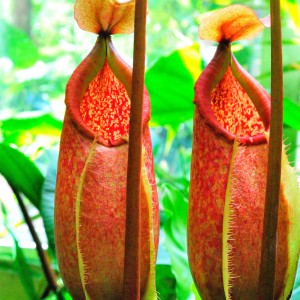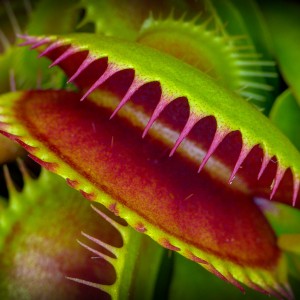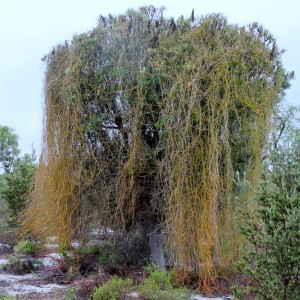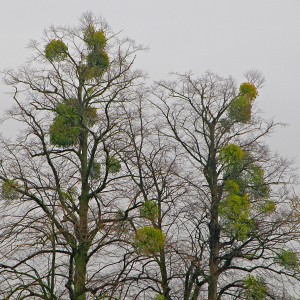Predatory Plants
In the plant kingdom, the survival instinct has triggered some rather unique adaptations forcing us to pause and rethink plant behavior. Predatory plants have managed to break the ‘rules’ by adapting for their own survival. In this post we will touch on the predatory nature of carnivorous and parasitic plants.
Carnivorous Plants
There are over 600 documented species of carnivorous plants worldwide. In nature, carnivorous plants are found growing in areas, such as bogs and marshes that lack the proper amounts of mineral nutrients, mainly nitrogen (N) and phosphorus (P) that encourage healthy plant growth and reproduction. The adaptation that led to the development of insect “traps” is one triggered by the lack of available nutrition. The leaves of carnivorous plants are where the adaptations have taken place resulting in a variety of different style “traps”. They include pitfall traps (pitcher plants), flypaper style traps (sundews), snap traps (Venus flytrap), suction traps (bladderworts) and lobster-pot traps. Two popular carnivorous plants that can be grown at home indoors and out are Venus Flytraps and Pitcher Plants.
Pitcher Plants
Pitcher plants are generally placed into two main families, the old world family Nepenthaceae and the new world family Sarraceniaceae. The old world species grow mainly in trees and develop a rather primitive looking pitcher where as the new world species grow from rhizomes in the ground and form a more complex pitcher from an entire leaf. Pitcher plants have been found growing all over the world in bogs and marshes with substandard sources of nitrogen (N) which in turn has led them to become carnivorous. Two popular sub sets of the new world species are the Sarracenia and the Darlingtonia (native to northern California and Oregon). Their pitchers create nectar that attracts insects and when the insect lands in the pitcher, the nectar traps them. An enzyme, much like of our own digestive enzymes, slowly kills and breaks down the constituent proteins within the insect. After the proteins are completely broken down, the plant is able to utilize the nitrogen (N) contained within. Pitcher plants can be grown at home both indoors and out. Just remember to simulate their natural environment as closely as possible. This requires using a growing medium that is inert and completely free of any mineral nutrient charge and remember use absolutely NO fertilizer. Pitcher plants have evolved to become carnivorous because of an extreme lack of mineral nutrition and that is what they thrive on.
Venus Fly Trap
Venus fly traps (Dionaea muscipula) are carnivorous plants native to the swamplands and bogs of North and South Carolina. They prey on insects with the help of very uniquely shaped leaves. The leaf blade is comprised of two lobes hinged together at a midrib. The surface of the leaf has ‘trigger hairs’. When a few of the trigger hairs are touched consecutively in a small amount of time the trap snaps shut, trapping the insect inside. The trap is lined with teeth like cilia that interlock with each other when the trap is closed, making escape for the insect nearly impossible. The leaf then begins creating digestive enzymes that will break the dead insect down into proteins and then into an available nitrogen source. Venus fly traps can also be grown at home inside (under T5 fluorescent lighting) or outside. Once again, use a potting soil that is void of mineral nutrients and do not fertilize.
Please Note: Most types of carnivorous plants are native to areas that are threatened by human development. This is why it is important to buy carnivorous plants for growing at home from reputable growers that start the plants by either splitting the rhizomes or from tissue culture propagation. In almost all cases it is illegal to gather carnivorous plants from the wild and those who get caught are levied with heavy fines.
Parasitic Plants
Parasitic plants vary from those which are fully photosynthetic to those which are just barely. Parasitic plants have circumvented the need to find nutrients in a small plot of soil by the development of a modified meristem root called a haustorium which can penetrate the vascular system of another plant, called a host. It steals vital mineral nutrients, water, and carbohydrates for its own benefit. This usually results in the death of the host plant. Parasitic plants can attack a host in a variety of ways ranging from the roots to the vascular tissue found in the stems. Two popular examples of parasitic plants are the several different species of mistletoe and the dodder vine.
Dodder Vine
The dodder vine (Cuscuta) is a wispy plant with thin stems that attaches to a host plant’s stems via its haustorium (modified root). The haustorium will reroute any water and mineral nutrients coming up from the roots as well the carbohydrates coming down from the leaves, the product of photosynthesis, directly to the roots of the dodder plant itself. Dodder seeds are very small and contain little initial sustenance so it is paramount that the dodder seedlings find a suitable host to feed upon within a few days or they may die. The Dodder aggressively attacks, engulfs, and eventually kills its host. This is why dodder is a threat to agriculture, especially in 3rd world and developing countries. A considerable amount of thought and attention is put into how to go about eradicating the plant from fields and pasture land.
Mistletoe
The plant family Loranthaceae is host to multiple species of mistletoe the most common of which is the species Phordendron serotinum, the eastern mistletoe. Eastern mistletoe is a flowering vascular plant that grows on the branches of trees where mineral nutrients are not present. Mistletoe is able to perform photosynthesis but it receives a majority of its mineral nutrient needs (via its haustorium) from the vascular system within the host trees branches. This adaptation is likely due to the fact that after birds eat the mistletoe berries they often excrete the remaining seeds onto the branches of the trees they frequent. The mistletoe seeds have also developed a sticky exterior which allows them to stick to the tree branches where they will germinate and grow. Growing on the branches of a tree helps keep the mistletoe plants safe from possible predators but this is also an environment that is nearly void of any mineral nutrition. Mistletoe plants parasitize the host tree and obtain needed nutrients to the detriment of the host itself.
Plants are not as passive as they seem. Several plant species throughout many different plant families have taken survival into their own hands with the development of certain appendages that have truly changed the game of normal plant behavior. These predatory plants remind us of the true beauty and complexity of the ever changing world we live in. What will they come up with next?






